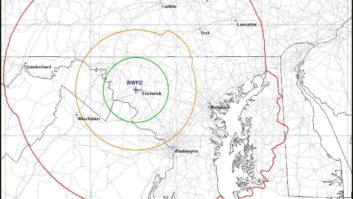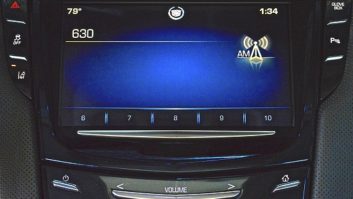Receiver Rollout, Surround Sound, Border Issues And Early Real-World Lessons Are Discussed
SAN DIEGO Digital radio is pushing forward on several fronts, and they were apparent at the NAB Radio Show here. The first tabletop HD Radio is due out next spring; several suppliers conducted demos of surround sound for digital radio; and Ibiquity and its manufacturing partners have upgraded the transmission software to better accommodate complex data applications and supplemental channels in the future.
Now that several major radios groups have committed to converting the bulk of their stations to HD Radio, Ibiquity sees 2005 as the year to get those radios into the hands of the public.
“We started selling radios this year,” said Ibiquity Digital President/CEO Robert Struble, referring to the January debut of the Kenwood IBOC radio. Panasonic and JVC also have digital radios on the market.
“I think ’05 is really going to be about getting many more radios out there and working with industry to drive consumer adoption of radios.”
Driving up the number
“We have now commitments in-hand to convert up to 2,500 stations over the next several years,” said Struble. “This will be the vast majority of listenership in the country and certainly gives us well beyond what we’ve been looking for – the critical mass to kick the rollout into high gear.”
Clear Channel, Cox, Entercom and Greater Media have committed to convert the majority of their stations.
Susquehanna Radio Director of Technical Operations Norm Philips said his company would have roughly all 30 of its stations converted by January of 2006. Eleven stations will be on with a digital signal by the end of November, and most of the remaining stations will convert next year. The total cost is roughly $4 million, he told Radio World.
There are about 140 stations on the air with HD Radio now, and three manufacturers of digital radios: Kenwood, JVC and Panasonic.
Receivers are due out soon from Jensen, Alpine, Sanyo, Visteon and Delphi, said Ibiquity Executive Director of Broadcast Business Development Scott Stull.
Boston Acoustics announced it would debut a tabletop HD Radio in the spring beginning at $299, which is significantly lower than the $500 to $1,000 models currently on the market. This unit will be able to accommodate supplemental audio channels, said several sources. To date, all the HD Radios on the market have been aftermarket units.
As it was with the satellite radio companies, getting the new radio into the dash is key to growing sales of digital radios. Ibiquity expects HD Radios to be original equipment in the dash on some car models at this time next year, beginning with luxury vehicles.
Stull said stations on the air with a digital signal are receiving calls from listeners curious about the technology. The company still hears occasionally from the man who purchased the first HD Radio this January.
“He still likes it,” said Stull.
To coincide with the promise of improved audio in the car, Orban, Omnia/Fraunhofer and Neural Audio showed surround demos for HD Radio. At least two FM stations broadcasting a digital signal and on which Radio World has reported have begun experimenting with 5.1 surround sound.
Broadcast engineering sources predicted one or two leaders would emerge in this product offering.
Frank Foti, president of Omnia Audio, went further. “We do need to adopt one system. If not, we’re wasting time.”
Neural Audio Co-Founder, CTO and Chief Scientist Robert Reams said whatever system broadcasters choose must be affordable.
On the station implementation front, Ibiquity has roughly 400 stations licensed and hopes to grow that to 1,300 by year-end, said Stull, who emphasized that the license fee to Ibiquity is a one-time expense, not an annual expense. He said there had been some confusion about this point.
Next FCC action
Observers and manufacturers have been anticipating further action from the FCC to formalize IBOC authorization. In order to complete its job, the commission is looking to the National Radio Systems Committee, which is working on a transmission standard for AM and FM IBOC. Various members queried by Radio World said they hoped the group would complete its work by the spring show.
Jim Bradshaw, an associate division chief of the Audio Division of the FCC’s Media Bureau, anticipates the commission releasing an order in early 2005. While that order likely won’t be the final IBOC authorization, he anticipates it could address AM nighttime authorization and supplemental audio channels.
He said he couldn’t say whether the AM nighttime language would be a blanket approval for all AMs to go IBOC at night. “We do have some concerns,” he said. NAB has submitted some interference resolution suggestions, he said; and whatever the commission decides, “It will give clear guidance on what stations experiencing interference can do.”
“Unlike FM, I think AM would have more specific interference mitigation criteria,” specified, he said.
NRSC Chairman Charlie Morgan said, “AM propagation doesn’t lend itself to repeatable tests. I think AMs that are on now (with IBOC) should be allowed on at night.”
Some FM broadcasters would like to use a simpler notification process if they plan to implement IBOC with dual antennas. Now, they need to apply for an STA from the FCC. Bradshaw acknowledged some broadcasters would like the STA requirement relaxed and this issue could potentially be included in the next IBOC notice, he said.
Bradshaw said it was too early to say what the commission would decide about supplemental audio – the concept of stations splitting the digital signal into more than one channel – although, he said, “It sounds like a great way to deal with competitors like satellite radio. It has promise.”
To advance the Tomorrow Radio project, NPR conducted tests this summer to determine if listeners could hear a difference in audio quality at bit rates of 12 to 25 kbps using different codecs. Previous tests for the split-channel concept kept the main digital channel data rate at 64 kpbs and the supplemental channel at 32 kbps.
Participants also wanted to determine whether radio reading services sounded better at lower bit rates, said Mike Starling, vice president of engineering for NPR. The group planned to submit tests results to the FCC sometime after the convention.
They learned that “flexibility is key” in determining the optimum bit rates for supplemental audio channels, said Starling.
IBOC beyond the borders
Ibiquity believes once it achieves momentum domestically, much of the Western Hemisphere will begin using is system.
“For a lot of different reasons, it makes sense,” said Struble. “The U.S. is the biggest market. The technology is thoroughly vetted by the FCC and there’s a lot of cross-border listening and advertising. It’s logical, and we think it’s happening.”
The Mexican government is looking to choose a system in 2005. Struble predicts both it and Brazil will “make news” with IBOC in ’05.
And what of our neighbor to the north, Canada? Its broadcast association is concerned about potential interference from U.S. IBOC stations to Canadian stations using analog signals. Although Canada is using the Eureaka-147 technology for digital radio on FM in six markets, it still relies heavily on analog in much of the country.
Ibiquity General Counsel Al Shuldiner said some Canadian broadcasters are concerned about IBOC’s impact on AM skywave signals. “We haven’t spent much time educating Mexican and Canadian regulators. We have time to let them know we don’t see a large impact on skywave. We see Canada and Mexico as logical extensions of service.”
Ibiquity plans to have those conversations with Canadian and Mexican regulators, he said.
Nautel, Broadcast Electronics and Harris showed new HD Radio-compatible equipment, which will be covered in an ensuing article here.








